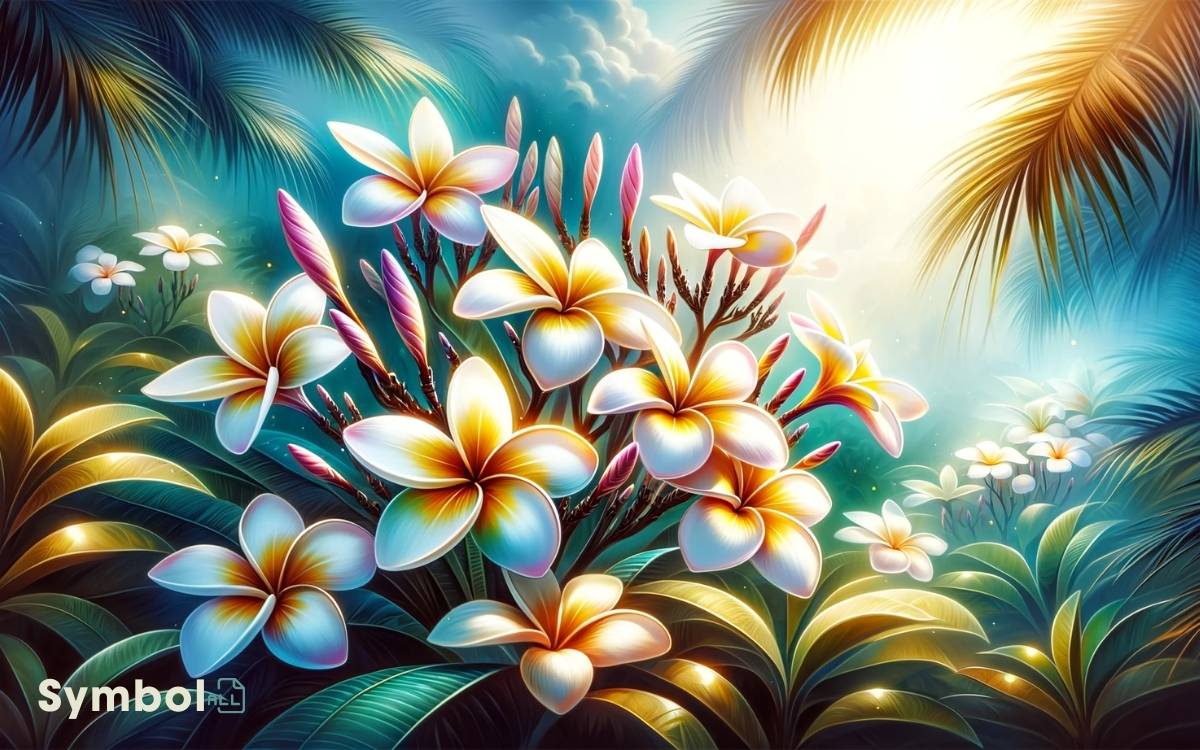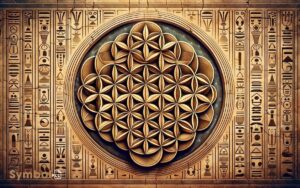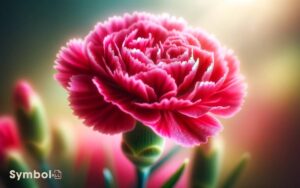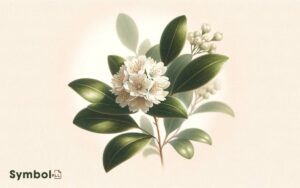What Does the Plumeria Flower Symbolize? Beauty!
Plumeria symbolizes a broad spectrum of concepts, encompassing beauty, adaptability, and spiritual renewal. It originated in regions like the Caribbean, reflecting a natural elegance and capacity to thrive under harsh conditions by shedding leaves during droughts.
In Hawaiian culture, it’s a symbol of life, renewal, and the Aloha spirit, integral to leis and pollination ecology. For the Mayans, it denoted life, rebirth, and elite status.
Notably, it represents love, eternal bonds, and spiritual awakening, embodying immortality and the continuous cycle of life and death across cultures. Exploring further, you’ll uncover its deep-rooted significance in rituals and modern symbolism.

Key Takeaways
The Origin of Plumeria
The Plumeria, known for its fragrant blooms and lush appearance, traces its origins to the warm climates of the Caribbean, Central America, and Mexico, where it first evolved millions of years ago.
As you explore its history, you’ll find that Plumeria’s survival and proliferation across tropical regions are attributed to its unique adaptation strategies.
Its vibrant flowers, which range in color from white to pink to red, aren’t just visually striking but also serve a critical role in attracting pollinators.
Moreover, Plumeria has developed a deciduous nature, shedding its leaves during drought periods to conserve water, showcasing its resilience.
These evolutionary traits have allowed Plumeria to not only survive but thrive in its native habitat, making it a symbol of natural beauty and adaptability.
Plumeria in Hawaiian Culture
Having explored its origins, it’s important to understand how Plumeria has woven itself into the fabric of Hawaiian culture, embodying symbols of life, beauty, and renewal.
In Hawaii, the Plumeria holds significant cultural value, often associated with grace and the Aloha spirit, representing welcoming and friendship.
Scientific analysis shows that its presence in rituals and adornments isn’t merely aesthetic. The Plumeria’s fragrant blooms play a critical role in pollination ecology, attracting specific pollinators that contribute to the sustenance of the island’s ecosystem.
Additionally, its use in leis and hula adornments reflects a deep-seated tradition of honoring and connecting with nature.
This practice underscores the Hawaiian belief in the interconnectedness of humans and the natural world, highlighting a respect for ecological balance and sustainability.
Symbolism in Mayan Civilization
In Mayan civilization, plumeria held profound symbolism, often representing life, rebirth, and the elite’s connection to the divine. This association is not merely anecdotal but is deeply embedded in their art, rituals, and folklore.
To understand the depth of plumeria’s significance, consider the following table:
| Aspect | Symbolism | Impact on Society |
|---|---|---|
| Life | Renewal | Celebrated through ceremonies |
| Rebirth | Transformation | Integral to spiritual beliefs |
| Elite Connection | Divine Proximity | Manifested in hierarchical structures |
| Art Representation | Sacred Symbolism | Enhanced cultural identity |
| Ritual Use | Spiritual Practice | Strengthened community bonds |
This framework elucidates the multifaceted roles plumeria played in Mayan society, underscoring its essential significance beyond mere ornamental use.
Love and Romance
You’ll find that the plumeria flower serves as a potent symbol in the domain of love and romance, encapsulating concepts of symbolic romantic gestures, the representation of an eternal bond, and the expression of passionate love.
These flowers, often utilized in wedding ceremonies and romantic gifts, carry a rich array of phytochemicals that are believed to stimulate emotional responses linked to love and commitment.
Analyzing the role of plumeria in romantic symbolism offers insights into its enduring appeal across cultures as a beacon of love, fidelity, and passion.
Symbolic Romantic Gestures
Often, the plumeria flower embodies deep-seated emotions of love and romance, serving as a symbolic gesture that communicates affection in a manner both intricate and profound.
When you present a plumeria to someone, you’re engaging in a ritual steeped in centuries of cultural significance.
This act isn’t merely about the aesthetic appeal of the blossom; it’s a nuanced expression of your feelings. Scientific analysis reveals that the plumeria’s vibrant colors and intoxicating fragrance stimulate the human brain’s limbic system, which is responsible for emotional responses.
This biological effect enhances the flower’s symbolic message of love, making it a powerful tool in the art of romantic expression.
In essence, gifting a plumeria is a meticulously crafted gesture, designed to convey complex emotions in a universally understood language of beauty.
Eternal Bond Representation
Building on the theme of romantic gestures, the plumeria flower also symbolizes an eternal bond of love and romance, with its enduring beauty and fragrance reflecting the lasting nature of deep affection.
In botanical terms, Plumeria spp. is known for its long-lived flowers and resilient nature, thriving in a variety of conditions. This resilience is metaphorically linked to the strength and permanence of true love.
Scientifically, the plumeria’s ability to bloom repeatedly, often from the same stem, serves as an emblem of love’s capacity to endure through challenges and time. Its fragrance, which intensifies at night, mirrors the deepening of emotional bonds in the darkness of adversity.
Ergo, the plumeria encapsulates the essence of an unbreakable, everlasting connection between two individuals, underpinned by mutual growth and adaptation.
Passionate Love Expression
The plumeria flower serves as a vibrant symbol of passionate love, its vivid hues and intoxicating scent igniting the flames of romance and desire.
Its biochemical composition, rich in phenylethylamine and serotonin, plays a pivotal role in eliciting emotional responses akin to those experienced during passionate love encounters.
These compounds stimulate the brain’s reward centers, intensifying feelings of pleasure and attachment.
| Compound | Emotional Influence |
|---|---|
| Phenylethylamine | Enhances feelings of euphoria |
| Serotonin | Elevates mood |
| Scopolamine | Induces feelings of elation |
| Benzyl Acetate | Stimulates senses |
| Linalool | Calms and soothes |
Plumeria’s olfactory and visual stimuli are not merely aesthetic but are intricately linked to its ability to symbolize and evoke passionate love.
Spiritual Significance
You’ll find that the Plumeria flower embodies profound spiritual significance across various cultures. It serves as a potent symbol of eternal life, hinting at the cyclical nature of existence and the belief in rebirth.
Additionally, its association with spiritual awakening and the promotion of peace and positivity underscores its role in fostering an environment conducive to personal and communal spiritual growth.
Eternal Life Representation
Throughout history, many cultures have revered the plumeria flower as a symbol of eternal life due to its enduring beauty and resilience.
This perception is deeply rooted in the flower’s exceptional ability to withstand various climatic challenges, thriving in conditions that would typically hinder the growth of less robust plants.
Scientifically, the plumeria’s lifecycle contributes to its symbolism. It follows a unique pattern of rebirth and regeneration, shedding its flowers only to bloom again with renewed vigor.
This cycle mirrors the concept of immortality, resonating with the human fascination with eternal existence.
Additionally, the plumeria’s long-lasting fragrance is often interpreted as the enduring essence of life, symbolizing the continuity of the soul beyond physical demise.
Spiritual Awakening Symbol
Plumeria flowers serve as powerful symbols of spiritual awakening, embodying the transformative journey of the soul towards enlightenment.
In a scientific analysis of their symbolism, it’s important to understand that plumerias aren’t merely ornamental; they carry deep ethereal significance.
Their blooming cycle represents the stages of spiritual development, from nascent awareness to full realization. The process through which a plumeria flower unfurls its petals mirrors the unfolding of spiritual enlightenment within an individual.
This phenomenon, observed under careful scrutiny, underscores an intricate relationship between natural growth patterns and spiritual evolution.
Additionally, the resilience and adaptability of the plumeria, flourishing in varied environments, parallel the soul’s capacity to thrive through spiritual challenges, making it a profound emblem for those on a path of self-discovery and inner transformation.
Peace and Positivity Essence
Building on the understanding of plumeria as a symbol of spiritual awakening, it’s notable that these flowers also embody the essence of peace and positivity, reflecting their broader spiritual significance. Plumerias, with their delicate fragrance and vibrant blooms, often inspire feelings of serenity and hope, making them a cherished emblem in many cultures. Similarly, exploring the azalea flower meaning and symbolism reveals themes of abundance, beauty, and heartfelt emotion, further enriching the interplay of floral significance. Together, these flowers remind us of the deep connections between nature, spirituality, and the shared human pursuit of harmony and understanding.
| Property | Significance |
|---|---|
| Color Variations | Indicate a spectrum of peace and positivity, with each hue representing a different aspect of tranquility and optimism. |
| Fragrance | Acts as a natural stress reliever, promoting a sense of calm and well-being. |
| Bloom Cycle | Symbolizes the continuous cycle of life, encouraging a positive outlook on change and renewal. |
| Cultural Association | Linked with ceremonies and rituals that emphasize harmony and joy, underscoring its role in fostering communal peace. |
This intricate association with peace and positivity highlights plumeria’s role in spiritual practices, offering a pathway to inner serenity and a positive mindset.
Plumeria in Hindu Beliefs
In Hinduism, the plumeria flower holds a significant place, symbolizing dedication and devotion to deities. This symbolism isn’t arbitrary but deeply rooted in the flower’s characteristics and historical usage.
The plumeria’s enduring bloom, even in challenging conditions, mirrors the Hindu ethos of persistence in faith and unwavering devotion amidst life’s trials.
Scientifically, the plumeria’s robustness can be attributed to its genus’ unique adaptation strategies, enabling survival in varied climates, paralleling the adaptability required in spiritual devotion.
Additionally, its sweet fragrance is believed to attract positive energies and deities, reinforcing its role in religious ceremonies. This symbolic association enhances the flower’s value beyond its aesthetic appeal, embedding it deeply within the spiritual fabric of Hindu culture.
Beauty and Charm
The Plumeria flower’s beauty isn’t just perceived; it’s a quantifiable attribute that contributes to its universal appeal.
You’ll find that its enchanting presence isn’t merely a result of its vibrant colors and unique shape, but also its ability to evoke strong emotional responses across diverse cultures.
This phenomenon is supported by numerous studies analyzing the psychological impact of floral aesthetics on human behavior and mood.
Universal Appeal
Plumeria flowers captivate audiences worldwide with their radiant beauty and enchanting fragrance, embodying a universal appeal that transcends cultural boundaries.
This global fascination isn’t merely aesthetic; it’s deeply rooted in the flower’s unique botanical characteristics.
Plumeria’s wide color spectrum, ranging from vibrant pinks to subtle whites, coupled with its complex fragrance profile, plays a pivotal role in its worldwide admiration.
Scientifically, the flower’s appeal can be attributed to its bilateral symmetry and high contrast in coloration, features that are known to attract human attention.
Additionally, plumerias have evolved to bloom prolifically, ensuring their presence is consistently felt, further cementing their status as a universally admired species.
Their ability to thrive in various climates adds to their global distribution and appeal, making them a symbol of beauty and charm across different cultures.
Captivating Presence
Every petal of the plumeria flower contributes to its captivating presence, showcasing a blend of beauty and charm that appeals to observers globally.
This mesmerizing presence isn’t merely superficial; it’s deeply rooted in the flower’s unique structure and pigmentation. Plumeria flowers exhibit a remarkable radial symmetry, which, from a scientific perspective, symbolizes balance and harmony.
The vibrant colors, ranging from stark whites to deep reds, are a result of complex biochemical processes involving anthocyanins and carotenoids. These pigments not only give the plumeria its visual appeal but also serve to attract pollinators, ensuring the survival of the species.
Additionally, the flower’s fragrance compounds, primarily consisting of terpenes, add another layer to its allure, blending aesthetics with ecological functionality.
Birth and Life Cycle
In its developmental journey, a plumeria seed undergoes a fascinating transformation, evolving from a dormant state into a vibrant, blooming flower.
Initially, the seed nestles into the soil, absorbing moisture and nutrients, triggering germination. This early stage is critical, as it sets the foundation for the plant’s future growth.
You’ll observe the emergence of a primary root, anchoring the seedling, and the unfolding of cotyledons, the first leaves, essential for photosynthesis.
As the plumeria matures, it develops a sturdy stem and a lush canopy of leaves, creating an ideal environment for flower buds to form.
These buds gradually swell, revealing intricate petals. The life cycle of the plumeria, from seed to bloom, embodies a remarkable journey of growth, resilience, and beauty, enchanting those who explore its study.
Immortality and Rebirth
In your exploration of the Plumeria flower’s symbolism, you’ll find its association with immortality and rebirth to be deeply rooted in various cultures.
The concept of eternal life is symbolized through the enduring beauty and resilience of the Plumeria, illustrating a profound connection to rebirth cultural meanings.
Additionally, the use of Plumeria in rituals underscores its significance in symbolizing a cycle of life, death, and regeneration.
Eternal Life Symbolism
Many cultures regard the plumeria flower as a potent symbol of eternal life, embodying concepts of immortality and rebirth through its enduring beauty and lifecycle.
This perception stems from the flower’s remarkable resilience and its cyclic blooming pattern, which mirrors the perpetual cycle of life and death.
Scientally, the plumeria’s ability to thrive in a variety of conditions and its long-lasting flowers contribute to its association with continuity and everlasting existence.
The plant’s propagation method, where new life sprouts from a segment of the parent, serves as a metaphor for regeneration and the undying soul.
Therefore, the plumeria not only captivates with its visual and olfactory appeal but also embodies deep symbolic meanings related to the eternal cycle of life.
Rebirth Cultural Meanings
The plumeria flower’s representation of rebirth and immortality is deeply rooted in its biological resilience and lifecycle, reflecting a profound cultural significance across different traditions. This resilience aligns with the cyclical nature of life, embodying renewal and eternal life.
From a scientific perspective, three key aspects highlight its symbolic meaning:
- Regeneration: Plumeria trees can regenerate from a branch cut and replanted, symbolizing new beginnings and the cycle of life and death.
- Durability: They withstand harsh conditions, blooming even after apparent death, paralleling the human spirit’s endurance.
- Seasonal Blooming: Their seasonal loss and regrowth of leaves and flowers mirror the idea of rebirth and immortality, encapsulating the essence of perpetual renewal.
These characteristics not only underscore the plumeria’s beauty but also its profound symbolism in the context of rebirth and immortality.
Plumeria in Rituals
Understanding the plumeria’s symbolic resilience and regeneration offers a foundation for exploring its integral role in rituals centered on themes of immortality and rebirth.
In these ceremonial contexts, the plumeria isn’t merely a decorative element; it’s a potent symbol, embodying the cyclical nature of life, death, and renewal.
Scientific analyses reveal that the plumeria’s perennial bloom cycle mirrors these existential concepts, offering a tangible manifestation of abstract ideas.
This correlation isn’t coincidental but deeply embedded in cultural practices that recognize the flower’s capacity to represent eternal life.
As you engage with the rituals that feature plumeria, you’re interacting with a complex interplay of natural phenomena and human belief systems, highlighting the flower’s ability to bridge the tangible and the spiritual domains.
Plumeria in Buddhism
In Buddhism, plumeria symbolizes immortality and spiritual devotion due to its ability to bloom even after being uprooted. This characteristic aligns with Buddhist principles that emphasize resilience and the continuity of life and spirit beyond physical existence.
Here are three key points to contemplate:
- Resilience in Adversity: The plumeria’s blooming post-uprooting mirrors the Buddhist teaching of enduring and thriving in the face of life’s challenges.
- Eternal Cycle of Life: Its perennial nature embodies the Buddhist belief in rebirth and the endless cycle of life and death.
- Devotion and Purity: The flower’s pristine beauty and fragrance are seen as manifestations of devotion and purity of the soul, central themes in Buddhist practice.
Understanding these connections provides deeper insight into the symbolic significance of plumeria within Buddhist traditions.
Positive Energy and Healing
Beyond its aesthetic appeal, plumeria flowers are believed to radiate positive energy, contributing considerably to healing practices across various cultures.
This belief stems from the flower’s complex biochemical makeup, which includes compounds known for their therapeutic properties. These compounds, when analyzed, demonstrate potential in promoting mental and physical well-being.
| Compound | Effect | Application |
|---|---|---|
| Linalool | Reduces stress | Aromatherapy |
| Acetophenones | Antimicrobial | Traditional medicine |
| Ursolic acid | Anti-inflammatory | Skin care |
The presence of linalool, for instance, is significant. It’s a terpene alcohol found in plumeria that’s widely recognized for its ability to alleviate stress and anxiety through olfactory stimulation.
Similarly, acetophenones and ursolic acid offer antimicrobial and anti-inflammatory benefits respectively, reinforcing the plumeria’s role in traditional healing practices. This scientific analysis underscores the flower’s capacity to harness and emit positive energy conducive to healing.
Plumeria in Filipino Tradition
Plumeria flowers hold a significant place in Filipino tradition, symbolizing not only beauty but also the resilience and grace under pressure that are highly valued in the culture. In the Philippines, the plumeria is deeply embedded in various cultural expressions and practices.
Here are three key aspects:
- Cultural Festivals: Plumeria flowers are extensively used in decorations and offerings during traditional Filipino festivals, signifying joy and celebration.
- Personal Adornments: The flowers are often worn by women in their hair during special occasions, symbolizing femininity and elegance.
- Architectural Motifs: Plumeria motifs can be found in Filipino art and architecture, representing the intricate relationship between nature and cultural identity.
These practices reflect the multifaceted role of plumeria in Filipino tradition, embodying both aesthetic appeal and profound cultural significance.
Death and Farewell
Exploring the symbolic dimensions of the plumeria flower reveals its poignant association with death and farewell rituals, embodying complex cultural attitudes towards the end of life.
In various cultures, the plumeria serves as a symbol for both the cycle of life and the inevitability of death, its blossoms used to honor the deceased and mark passages into the afterlife.
Scientific analysis shows that the plumeria’s enduring fragrance and vibrant colors contribute to its selection for these solemn occasions, offering a sensory reminder of life’s transient beauty and the permanence of memory.
Its presence in funeral rites and gravesites serves not only as a tribute but also as a means of facilitating the emotional processes of grieving and letting go, illustrating the flower’s integral role in the delicate balance between remembering and releasing.
Plumeria in Modern Times
In modern times, the plumeria flower has transcended its traditional roles, finding new significance in various scientific and cultural contexts.
You’ll discover its impacts aren’t just aesthetic but also extend to:
- Pharmacological Research: Scientists are investigating plumeria’s compounds for potential medicinal properties, including anti-inflammatory and analgesic effects. This exploration could lead to new, plant-based pharmaceuticals.
- Genetic Studies: Horticulturists are experimenting with plumeria’s genetics to breed new varieties with enhanced qualities, such as increased resistance to pests and diseases, or more vibrant colors and fragrances, enriching biodiversity.
- Cultural Revival: Communities are re-embracing plumeria in traditional ceremonies, fostering a reconnection with heritage and promoting cultural identity through its symbolic meanings of life, beauty, and grace.
This evolution of plumeria’s roles underscores its enduring significance and adaptability in modern society.
Conclusion
To sum up, plumeria flowers, like stars in a vast universe, hold profound meanings across cultures. They’re not just botanical wonders but also symbols of love, spirituality, and the cyclical nature of life and death.
Analyzing their significance reveals a rich tapestry of human emotion and belief systems, akin to dissecting a complex organism under a microscope. Each petal carries a story, a tradition, or a healing promise, making plumeria an emblem of humanity’s interconnectedness with nature.






